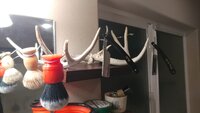I'm brand new to straights and this was a great read for me, thanks.
One question: What is meant by a "pull stroke"?
I just finished reading the whole thread....very enlightening.
However Im still unclear as to what a 'pull' stroke really is.
I saw a photo of a kamisori lying on the stop with a red arrow indicating
that the blade needs to be pulled sideways by an inch or so....I just cant
visualise this step without thinking it might slice the balsa.

